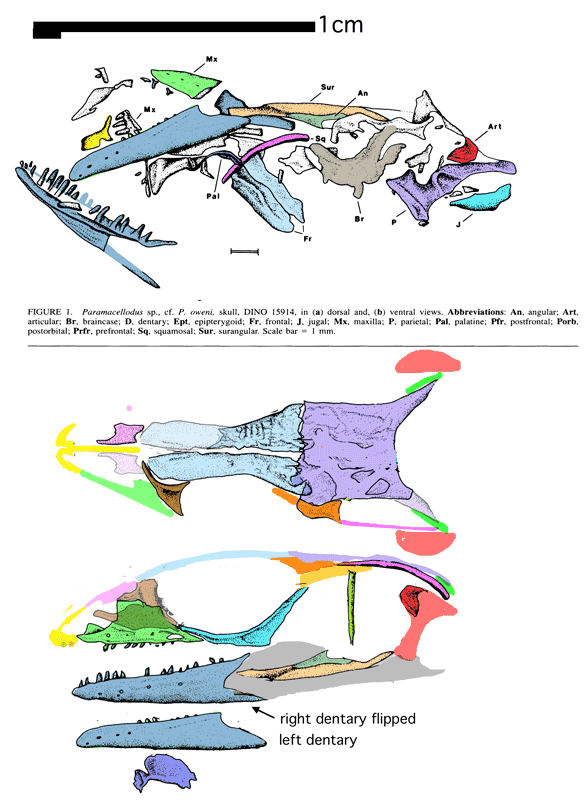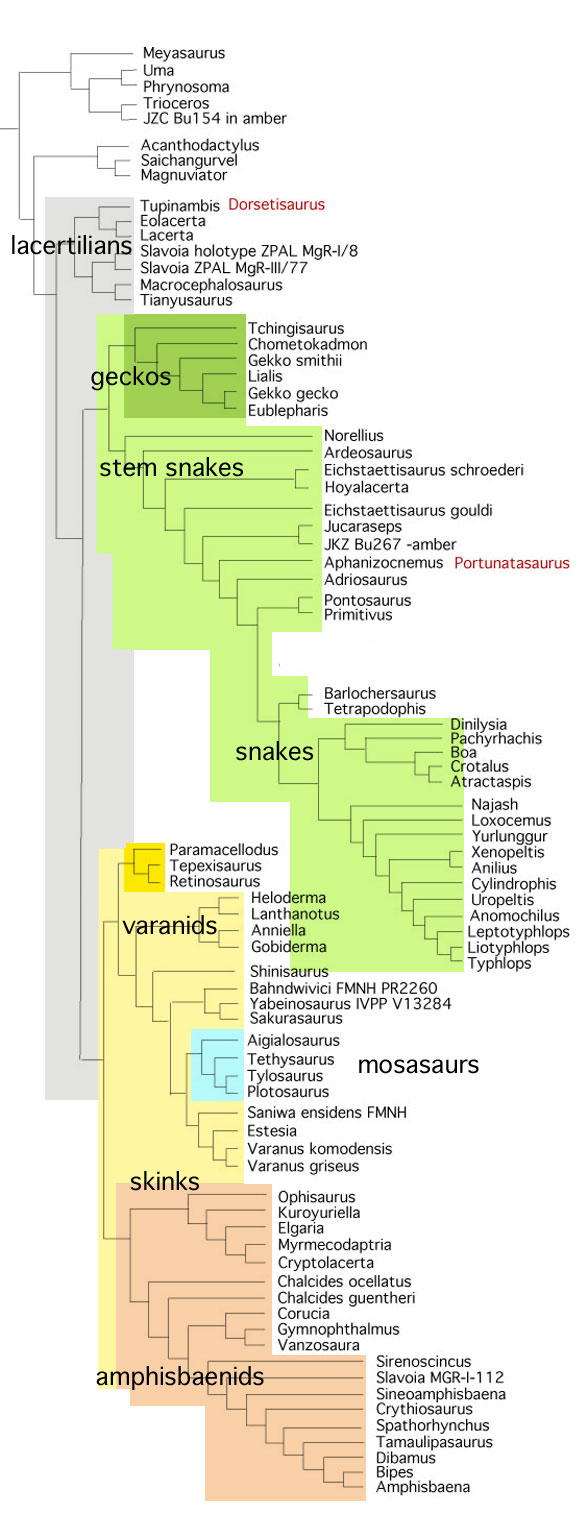Meyer, Brownstein and Gauthier 2021 report:
“Squamates, with more than 11,000 species, are a major portion of extant tetrapod biodiversity. However, their phylogenetic relationships remain highly contested between hypotheses generated from morphological versus molecular data.”
There is a long history of other workers are also seeing this difference.
Don’t trust genes in deep time studies. Use the hard evidence of traits and fossils.
“This may be due in part to poor sampling of stem members of disparate crown clades, particularly from the Jurassic, when most of the crown ‘backbone’ clades are estimated to have originated.”
No. We have a good sampling in the LRT. Add extant taxa to fossil cladograms, as in the large reptile tree (LRT, 1991 taxa, subset Fig. 2) to make your ‘poor sampling’ better.

Meyer, Brownstein and Gauthier 2021 continued:
“Here, we identify a stem gekkotan from the Kimmeridgian Brushy Basin member of the Morrison Formation. This new species replaces the Tithonian Eichstaettisaurus as the oldest
stem gekkotan currently known.”
Neither is a stem gekkotan. In the LRT Eichstaettisaurus (Fig. 1) is in the snake lineage (Fig. 2), a sister clade to the gekko clade. Just add pertinent taxa to find this out for yourself.
Meyer, Brownstein and Gauthier 2021 continued:
“This identification is based on a reexamination of specimen DINO 19514. It consists of a disarticulated partial skull including the maxillae, prefrontals, frontals, parietal, left jugal, right postfrontal and squamosal, partial braincase, both dentaries, and the fused left postdentary
bones. Previous examination of DINO 19514 assigned it to the scincomorph Paramacellodus.”
DINO 19514 (Fig. 3) was described earlier by Evans and Chure 1998.

In the LRT the DINO 19514 specimen of Paramacellodus nests with two other Early Cretaceous small to flat-headed lizards, equally small Tepexisaurus and tiny Retinosaurus (Fig. 4). These three are in their own clade basal to the large clade that includes Heloderma + varanids + mosasaurs + skinks + amphisbaemids (Fig. 2).
So Paramacellodus is neither gekko nor skink.

Meyer, Brownstein and Gauthier 2021 continued:
“We utilize μCT to re-examine the morphology of DINO 19514 in previously inaccessible detail and find it to be a new taxon that is neither Paramacellodus nor a scincomorph. This new taxon is diagnosed by an enlarged pineal foramen, a relatively wide inter-orbital portion of the frontals (more than 50% of the width of the frontoparietal suture), a postfrontal fused to the postorbital, and a wide parietal nuchal fossa. We incorporated DINO 19514 into a large squamate dataset (165 out of 791 characters x 169 species). Unconstrained maximum- and implied-weights (K=12) parsimony infer it as the earliest-diverging stem gekkotan, sister to a clade containing Eichstaettisaurus, Norellius and crown gekkotans.”
In the LRT (subset Fig. 2) Norellius is another lizard closer to snakes than gekkos. Meyer et al. make no mention of two basal gekkotans in the LRT: Tchingisaurus and Chometokadmon, so one wonders whether or not taxon exclusion is a problem here.
“DINO 19514 grants insight into the condition at the base of Pan-Gekkota. As in other stem gekkotans, it has paired frontals, in contrast to the fused condition of the crown. While incomplete, it is apparent that the subolfactory frontal processes are like those of other stem gekkotans in being intermediate between the ancestral squamate condition and the crown gekkotan condition in which they meet and fuse on the ventral midline. Likewise, the elevated marginal tooth count of DINO 19514 is intermediate between the low ancestral count and the high count of crown gekkotans. A lack of palatal dentition unites it with stem and crown gekkotans, pushing this loss to the Jurassic. The posterior teeth are unicuspid, a feature that it shares with other stem and basal crown-gekkotans.”
Evans and Chure 1998 published on DINO 19514 before the descriptions of and Tepexisaurus (2020). So they had no idea these two would someday be related. Meyer, Brownstein and Gauthier 2021 do not mention these taxa, so they may have omitted them, and the stem gekkotans and stem snakes listed above (Fig. 2). Wait for the paper.
References
Evans SE and Chure DJ 1998. Paramacellodid lizard skulls from the Jurassic Morrison Formation at Dinosaur National Monument, Utah. Journal of Vertebrate Paleontology. 18 (1): 99–114.
Hoffstetter R 1967. Coup d’oeil sur les Sauriers (=lacertiliens) des couches de Purbeck (Jurassique supérieur d’Angleterre). Coloques Internationaux du Centre National de la Recherche Scientifique 163:349–371.
Meyer D, Brownstein CD and Gauthier J 2021. Computed tomography reveals a Jurassic stem-gekkotan from the Morrison Formation. Journal of Vertebrate Paleontology abstracts.
wiki/Paramacellodus
wiiki/Tepexisaurus – not yet posted

